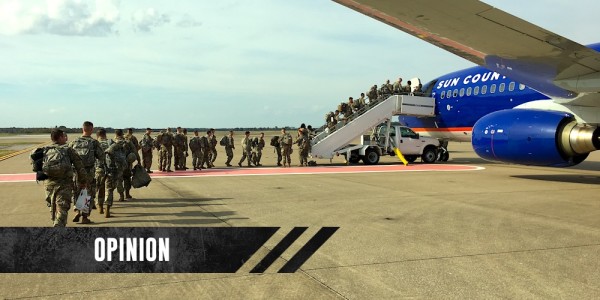

The current plan to send at least 7,000 active-dutyU.S. troops to the southern border for Operation Faithful Patriot undermines Secretary of Defense James Mattis’ entire defense strategy for the military.
Admittedly, while the current mobilization effort is due to the current political climate and commander-in-chief’s penchant for theatrics, it is another example of how politicians and presidents have an increasingly expansive view of the role of the military. While presidents have occasionally sent troops to guard the U.S. border with Mexico, it exemplifies mission and role creep of the U.S. armed forces and a trend Mattis has attempted to do away with. This particular mobilization raises a few issues: the ongoing use of military resources for things other than war and deterrence.
Of particular note is Operation Faithful Patriot’s mobilization of active-duty troops rather than additional National Guard troops. There is an existing security mission to the border, called Operation Guardian Support, which has assigned 2,100 troops to the border with up to 4,000 Guard troops authorized. This operation primarily provides air support for counter-narcotics efforts. Due to constraints of the Posse Comitatus Act, which prevents U.S. troops from engaging in military or law enforcement actions on U.S. soil outside of military installations, the existing NG and new active-duty troops will be in support roles only.
‘Support’ may seem benign, but it points to the larger issue of how the military is and should be employed both domestically and internationally.
Opportunities for mission creep are possible given the tasks the military will be performing on the border: Guard troops currently complete “vehicle maintenance, administrative duties, monitoring of surveillance data collected through cameras and sensors along the border, and clearing vegetation to improve sight lines in the field,” according to Stars & Stripes; the newly mobilized active-duty troops will be “constructing barriers and fencing, using helicopters and fixed-wing aircraft to move CBP personnel, and dispensing medical care.”
This mobilization illustrates potential challenges in applying the 2018 National Defense Strategy’s redefinition of the U.S. military’s role in American foreign policy. The NDS envisions “combat-credible military forces to deter war and protect the security of our nation” requiring a “transformation of how the [DoD] conducts business.” The strategic approach requires the military to primarily conduct deterrence and war rather than operating as one-stop-shop for all challenges facing the country or the world.
“‘Support’ may seem benign, but it points to the larger issue of how the military is and should be employed both domestically and internationally.”
Extracurricular missions in which the military engages in operations other than war have become commonplace in the past few decades, ranging from providing immediate aid for Ebola (West Africa), medical relief such as U.S. Africa Command’s Malaria Task Force (East and West Africa) and HIV screening and circumcision (Botswana), to building schools and governments (Iraq and Afghanistan).
But mobilizing troops, even as “defense support for civilian authorities,” is what Mattis has been trying to move away from: clearly, there is an issue with presidents and Congress viewing the military as a solution to any problem.
The justification behind sending active-duty troops offered by Gen. Terrence O’Shaughnessy, commander of U.S. Northern Command, has been that they will provide “additional capability” to existing Guard troops and border control. However, the Department of Homeland Security has spent billions supporting state and local agencies with counterterrorism and border control, including buying new military gear that spans from small surveillance drones to body armor to explosive entry equipment. The increased capabilities assigned to the border and local agencies would seem to indicate that DHS and Customs and Border Protection already possess the ability to manage border security.
Furthermore, there is a certain futility in sending troops to the border. While costs of recent mobilizations seem inconsequential against the larger DoD budget, it is a massive outlay compared to the budgets of aid organizations:Specifically, according to the National Guard, “the cost of border operations carried out by Title 32 forces, conducted from June 2006 to July 2008 and again from July 2010 to June 2011 is about $1.35 billion.” Compare that to the first year of Operation Phalanx 2010-2016, the mission cost $110 million. Other estimates show that specific military support for counterdrug operations averages $10 million “with additional operational costs borne by the military services.”
By comparison, USAID’s budget is only in the tens of billions, compared to the hundreds of billions of the DoD, and the agency annually provides economic support to Central America to encourage economic security and good governance to address the root cause of migration and country destabilization. An administration that was serious about stemming a tide of migrants would focus more on supporting these efforts by USAID rather than by sending troops on an ill-defined mission that is outset of their defined role. This money could be better spent modernizing systems and improving readiness.
In many ways mobilizing troops to the U.S.-Mexico border is within presidential rights and has been done regularly since 9/11 by Presidents Bush and Obama. The willingness to send troops, however, is illustrative of the U.S. military’s mission creep into non-war activities when demanded by the president and Congress. Despite Mattis’ attempt to confine the military into more explicitly warfighting activities, his efforts to increase lethality are disregarded by politicians who increasingly use the military as a “fix-all.”
The military cannot solve every problem, and attempting to use the military to do so only takes funding away from efforts needed to refocus the military on the nation’s most critical challenges.
Emma Moore is a Research Assistant on the Military, Veterans, and Society program at Center for a New American Security (CNAS)